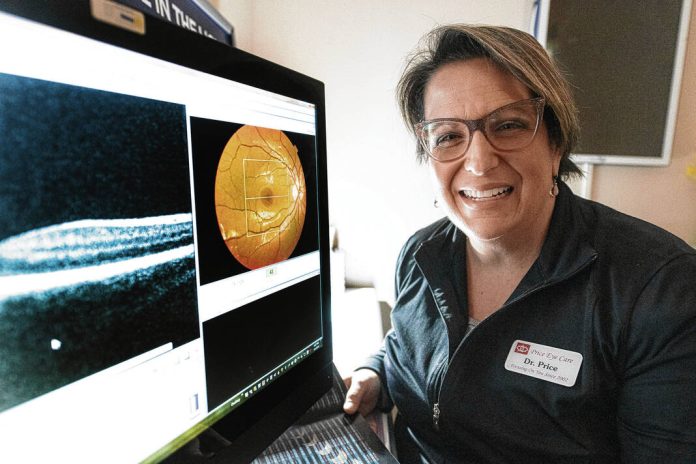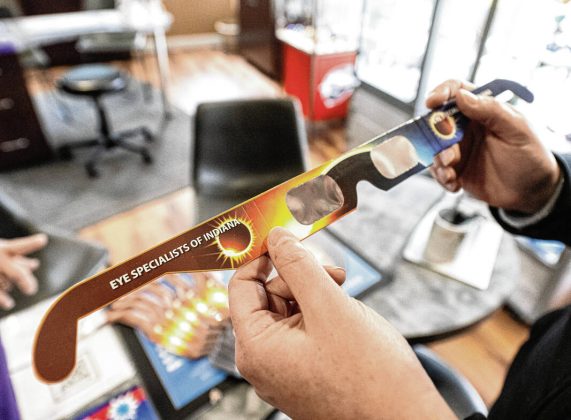
Monica Price Kowaleski of Price Eye Care in Greenfield talks about how to observe the upcoming eclispe by wearing special eclipse glasses that are compliant with the ISO12312-2 international standard.
HANCOCK COUNTY — Greenfield optometrist Monica Price is urging the public to protect their eyes during the upcoming eclipse Monday, April 8.
Her words of advice were recently featured in Women In Optometry, an online publication focused on female optometrists throughout the country.
While the much anticipated eclipse will last just around 2 ½ hours total, Price said the resulting damage to unprotected eyes can last a lifetime.
Failing to take the proper precautions when viewing the eclipse for as little as a few seconds can lead to solar retinopathy — also known as eclipse retinopathy — which is essentially irreparable damage of the eyes on a molecular level.
“Basically there is no cure for solar retinopathy,” Price said. “Once the damage is done it’s permanent, so it’s of the utmost importance to protect your eyes because there is no replacement of that tissue. There’s no medicine or pill or treatment that can help, so there’s not a lot we can do.”
Symptoms can begin within hours to days after the initial damage, said Price, a second generation optometrist with 22 years experience.
She was among a number of eyecare experts who listened in on a lecture this week hosted by the Indiana Optometric Association, which encourages everyone planning to watch the eclipse to wear protective eyewear.
The lecture was presented by Dr. Hin Cheung, a professor at the Indiana University School of Optometry, who warned against the dangers of looking into the sun.
Only special eclipse glasses labeled ISO 12312-2 are suitable for viewing the eclipse, said Price, who has been selling the glasses at her Greenfield optometry office for $1.
“We wanted to help provide an affordable, safe way for people to view the eclipse. These are the same glasses my family will be using,” said Price, who urges the public to heed warnings about fake eclipse glasses on the market that won’t provide proper protection.
“One way to know if your glasses are working correctly is when you wear them and look at a normal (illuminated) lightbulb, you should see nothing at all. If you look at the sun you should be able to see its round shape, so it almost looks like the moon, but it takes all the rays away,” Price said.
Wearing sunglasses or damaged eclipse glasses won’t protect your eyes and can lead to permanent damage, she said.
“If your eclipse glasses have scratches or they’re damaged in any way you should not use them. The scratches will allow light through and that’s not good,” said Price, who warns that it’s not worth the risk.
There’s a brief moment when it is safe to view the eclipse without glasses, said Price, and that’s during what’s known as totality, when the moon completely blocks out the sun.
The short window in which the moon completely eclipses the sun is the only time it’s safe to look up at the eclipse without protective eyewear, said Price, adding that the window of totality in Hancock County should last from 3:06-3:10 p.m.
It’s during that relatively brief time that viewers will see what experts call a diamond ring, which is essentially the glow of the sun visible around the edge of the moon.
Price advises eclipse watchers to take care and be sure to have their glasses back on before the moon shifts at the end of totality, making the sun’s rays visible once again.
She also warned against watching the eclipse through a camera, telescope or binoculars, which can magnify the sun’s harmful rays. Doing so can cause a thermal burn, she said, irreparably damage the equipment as well as your eyes.
If using such a device to view or capture the eclipse, a specialized filter or eclipse viewing glasses need to be firmly secured to the lens of the device, with viewers taking care to look into the device and not up towards the sun.
“Put the filter over your equipment, not over your eyes,” Price said.
PLAY IT SAFE
Not taking the proper precautions when viewing the eclipse can lead not only to solar retinopathy but photokeratitis, which is a painful eye condition caused by exposure to ultraviolet rays, similar to sunburn.
“That we can treat if it’s not super severe, but it’s usually uncomfortable and cause a burning sensation of eyes on the surface,” Price said.
While photokeratitis affects the cornea on the surface of the eye, solar retinopathy causes blisters and damages the outer retinal cells at a molecular level.
“If it hits the right cells there could be permanent damage,” Price said. “It would cause central blindness which affects your central vision, which is what you use to watch TV, drive, read — anything you look at with any detail.”
She encourages anyone experiencing “blurry vision, decrease in vision, wavy or distorted lines, or something just doesn’t seem right,” to schedule an appointment with an eye care professional as soon as possible.
In hearing the eclipse lecture for optometrists earlier this week, Price learned a few things she didn’t know, like the fact that the first sight of the moon starting to cover the sun is known as “first bite.”
“It looks like it takes a little bite out of the sun. When looking at the sun it will be right about 4:30 as if you’re looking at a clock dial,” she said.
She was also surprised to learn about “eclipse chasers” who will travel around the world to get a glimpse of total eclipses around the world.
Price also learned how rare the opportunity to view a total eclipse really is.
“They told us the last total eclipse in Indiana was in the year 1205, and the next won’t occur until 2153,” said the optometrist, who also learned that people have been fascinated by eclipse viewing since the dawn of time.
“The lecturer shared that even Plato warned against watching solar eclipses in 400 B.C., and that Galileo, the father of astronomy, had solar retinopathy because he studied the sun,” she said.
To avoid making Galileo’s mistake, she encourages eclipse viewers to obtain glasses from Hancock County Tourism or other local organizations coordinating eclipse viewing events. Glasses can also be purchased at her Price Eye Care office, at 946 N. State St. in Greenfield, from 9-11 a.m. Monday.
For a full list of eclipse viewing sites in Hancock County, visit eclipseinhancock.org.





